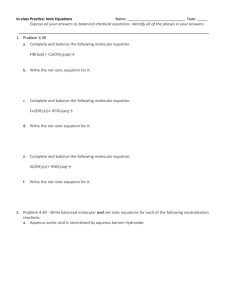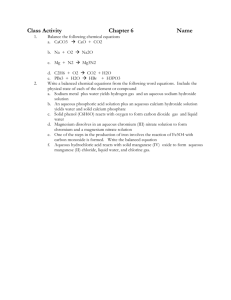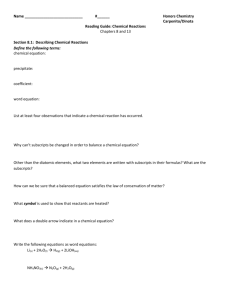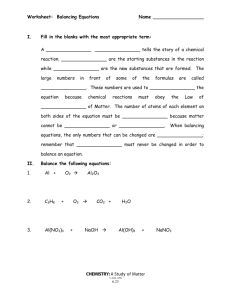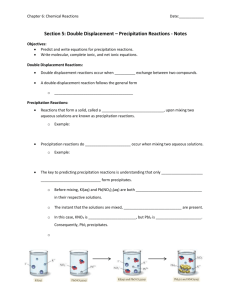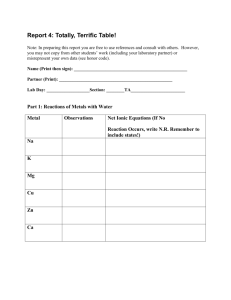Honors Chapter 11 Powerpoint
advertisement
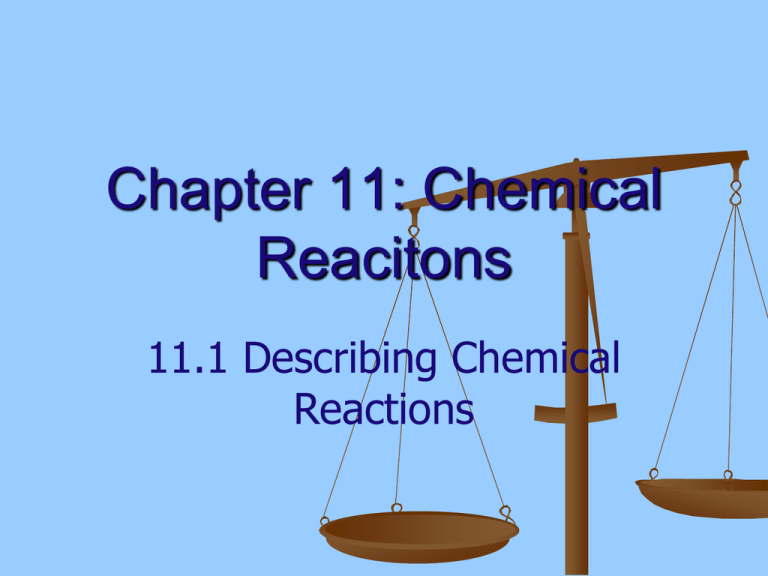
Chapter 11: Chemical Reacitons 11.1 Describing Chemical Reactions Signs of a Chemical Reaction Color change Solid forms (precipitate) Bubbles (gas) produced Change in temperature 11.1 Writing Chemical Equations Word Equations To write a word equation, write the names of the reactants to the left of the arrow separated by plus signs; write the names of the products to the right of the arrow, also separated by plus signs. Reactant + Reactant Product + Product 11.1 Writing Chemical Equations Chemical Equations A chemical equation is a representation of a chemical reaction; the formulas of the reactants (on the left) are connected by an arrow with the formulas of the products (on the right). 11.1 Writing Chemical Equations A skeleton equation is a chemical equation that does not indicate the relative amounts of the reactants and products. Here is the equation for rusting: Fe + O2 Fe2O3 11.1 Writing Chemical Equations A catalyst is a substance that speeds up the reaction but is not used up in the reaction. Without Catalyst With Catalyst 11.1 Writing Chemical Equations for Conceptual Problem 11.1 11.1 Balancing Chemical Equations To write a balanced chemical equation, first write the skeleton equation. Then use coefficients to balance the equation so that it obeys the law of conservation of mass. 11.1 Balancing Chemical Equations This is a balanced equation for making a bicycle. The numbers are called coefficients—small whole numbers that are placed in front of the formulas in an equation in order to balance it. 11.1 Balancing Chemical Equations A chemical reaction is also described by a balanced equation in which each side of the equation has the same number of atoms of each element and mass is conserved. Helpful Tips Balance one element at a time. Update ALL atom counts after adding a coefficient. If an element appears more than once per side, balance it last. Balance polyatomic ions as single units. “1 SO4” instead of “1 S” and “4 O” for Conceptual Problem 11.2 for Conceptual Problem 11.2 Example Solid calcium metal reacts with water to form aqueous calcium hydroxide and hydrogen gas. Hydrogen Example peroxide in an aqueous solution decomposes to produce oxygen and water Example Solid copper metal reacts with aqueous silver nitrate to produce solid silver metal and aqueous copper (II) nitrate Practice 1) Solid mercury (II) oxide decomposes to produce liquid mercury metal and gaseous oxygen 2) Solid carbon reacts with gaseous oxygen to form gaseous carbon dioxide Practice 3) Gaseous ammonia reacts with gaseous hydrogen chloride to form solid ammonium chloride 4) Iron metal reacts with oxygen gas to form solid iron (II) oxide Practice 5) Solid magnesium reacts with liquid water to form solid magnesium hydroxide and hydrogen gas 6) Gaseous ammonia reacts with gaseous oxygen to form gaseous nitrogen monoxide and gaseous water Practice 7) Nitrogen monoxide gas reacts with hydrogen gas to form nitrogen gas and water 8) Lithium metal reacts with chlorine gas to form solid lithium chloride 11.1 Section Quiz. 1.Propane gas reacts with oxygen to produce water vapor and carbon dioxide. Choose the correct word equation for this reaction. a) propane + carbon dioxide water + oxygen b) propane + oxygen + water carbon dioxide c) propane + oxygen + water + carbon dioxide d) propane + oxygen water + carbon dioxide 11.1 Section Quiz. 2. Which of the following is a skeleton equation? a) H2 + CO CH3OH b) 2H2 + CO CH3OH c) 2H2 + CO2 CH3OH d) hydrogen + carbon monoxide methanol 11.1 Section Quiz. 3. What coefficient for H2SO4 is required to balance the following equation? Ca3(PO4)2 + ____ H2SO4 3CaSO4 + 2H3PO4 a) 1 b) 2 c) 3 d) 4 11.2 Types of Chemical Reactions 11.2 Classifying Reactions The five general types of reaction are combination, decomposition, singlereplacement, doublereplacement, and combustion. 11.2 Classifying Reactions A combination (synthesis) reaction is a chemical change in which two or more substances react to form a single new substance. Combination only one product A + B AB for Conceptual Problem 11.4 Aluminum and sulfur react Sodium metal and iodine gas react 11.2 Classifying Reactions A decomposition reaction is a chemical change in which a single compound breaks down into two or more simpler products. Decomposition only one reactant AB A + B for Conceptual Problem 11.5 Aluminum oxide(s) decomposes when electricity passes through it Magnesium bromide(s) decomposes Decomposition Patterns Metal carbonates break down to produce a metal oxide and carbon dioxide gas. Ex: CaCO3(s) → CaO(s) + CO2(g) Metal hydroxides (except group 1 metals) decompose to yield metal oxides and water. Ex: Ca(OH)2(s) → CaO(s) + H2O(g) Decomposition Patterns Metal chlorates decompose to produce a metal chloride and oxygen. Ex: 2 KClO3(s) → 2 KCl(s) + 3 O2(g) 11.2 Classifying Reactions A single-replacement reaction is a chemical change in which one element replaces a second element in a compound. Single Replacement metal replaces metal nonmetal replaces nonmetal A + BC B + AC 11.2 Classifying Reactions The activity series of metals lists metals in order of decreasing reactivity. for Conceptual Problem 11.6 11.2 Classifying Reactions A double-replacement reaction is a chemical change involving an exchange of positive ions between two compounds. Double Replacement AB + CD AD + CB for Conceptual Problem 11.7 11.2 Classifying Reactions A combustion reaction is a chemical change in which an element or a compound reacts with oxygen, often producing energy in the form of heat and light. for Conceptual Problem 11.8 1) 2) 3) 4) 5) Classify 2K + Cl2 → 2KCl Fe2O3 + 2Al → Al2O3 + 2Fe 2Mg + O2 → 2MgO HNO3 + NaOH → H2O + NaNO3 KBr + AgNO3 → AgBr + KNO3 Classify 6) PbO2 → Pb + O2 7) 2C2H2 + 5O2 → 4CO2 + 2H2O 8) 2Ni + 4O2 → 2NiO 9) 4NH3 + 5O2 → 4NO + 6H2O 10) S8 + 8O2 → 8SO2 Classify 11) 2Al + Cl2 → 2AlCl3 12) 2AlN → 2Al + N2 13) BaCl2 + Na2SO4 → BaSO4 + 2NaCl 14) 2Cs + Br2 → 2CsBr 15) KOH + HCl → H2O + KCl 1. 11.2 Section Quiz. What type of reaction is described by the following equation? 6Li + N2 2Li3N a) combination reaction b) decomposition reaction c) single-replacement reaction d) combustion reaction 11.2 Section Quiz. 2. Balance and indicate reaction type. H2SO4 H2O2 + SO2 a) H2SO4 H2O2 + SO2, combination reaction b) H2SO4 H2O2 + SO2, decomposition reaction c) H2SO4 2H2O2 + SO2, combination reaction d) H2SO4 2H2O2 + SO2, decomposition reaction 11.2 Section Quiz. 3. Predict the missing product in the following unbalanced equation. Pb(NO3)2 + KOH KNO3 + ____ a) PbOH2 b) Pb(OH)4 c) Pb(OH)2 d) PbOH 11.3 Reactions in Aqueous Solution 11.3 Net Ionic Equations A complete ionic equation is an equation that shows dissolved ionic compounds as dissociated free ions. 11.3 Net Ionic Equations An ion that appears on both sides of an equation and is not directly involved in the reaction is called a spectator ion. The net ionic equation is an equation for a reaction in solution that shows only those particles that are directly involved in the chemical change. 11.3 Net Ionic Equations A net ionic equation shows only those particles involved in the reaction and is balanced with respect to both mass and charge. Conceptual Problem 11.9 for Conceptual Problem 11.9 Example – Write the Complete and Net Ionic Equations Pb(NO3)2(aq) PbSO4(s) + Na2SO4(aq) → + 2NaNO3(aq) 11.3 Predicting the Formation of a Precipitate You can predict the formation of a precipitate by using the general rules for solubility of ionic compounds. 11.3 Predicting the Formation of a Precipitate 11.3 Predicting the Formation of a Precipitate Will a precipitate form when a sodium carbonate solution is mixed with a barium nitrate solution? Practice – predict products and determine solubility 1) 2) 3) 4) 5) KNO3(aq) + BaCl2(aq) Na2SO4(aq) + Pb(NO3)2(aq) KOH(aq) + Fe(NO3)3(aq) Ba(NO3)2(aq) + K3PO4(aq) Na2SO4(aq) + KCl(aq) Practice 1) When aqueous barium nitrate is added to aqueous sodium sulfate, a white solid forms. 2) When aqueous lead (II) nitrate is added to aqueous potassium iodide, a yellow solid forms. Reactions that form water Example: hydrobromic acid + aqueous sodium hydroxide Reactions that form water Sulfuric acid + aqueous potassium hydroxide Hydrochloric acid + aqueous calcium hydroxide Reactions that form gases Example: hydroiodic acid and aqueous lithium sulfide react Reactions that form gases Perchloric acid reacts with aqueous potassium carbonate, forming carbon dioxide gas and water (and another product) Reactions that form gases Sulfuric acid reacts with aqueous sodium cyanide forming hydrogen cyanide gas (and another product) 11.3 Section Quiz. 1. Identify the correct net ionic equation and any spectator ions. FeO(s) + 2HClO4(aq) H2O(l) + Fe(ClO4)2(aq) a) FeO(s) + 2H+(aq) + 2ClO4-(aq) H2O(l) + Fe2+(aq) + 2ClO4-(aq); no spectator ion b) FeO(s) + 2H+(aq) + 2ClO4-(aq) H2O(l) + Fe2+(aq) + 2ClO4-(aq); ClO4- is a spectator ion c) FeO(s) + 2H+(aq) H2O(l) + Fe2+(aq); ClO4d) FeO(s) + 2HClO4(aq) H2O(l) + Fe(ClO4)2(aq); no spectator ion 11.3 Section Quiz. 2. Which one of the following products of double-replacement reactions would NOT form a precipitate? a) AgCl b) PbSO4 c) Mg(OH)2 d) Mo(NO3)2 11.3 Section Quiz 3. Which reaction will NOT produce a precipitate from aqueous solution? a) Hg2(NO3)2 + KCl b) FeSO4 + Ba(OH)2 c) Pb(NO3)2 + Na2CO3 d) NaBr + Al2(SO4)2
